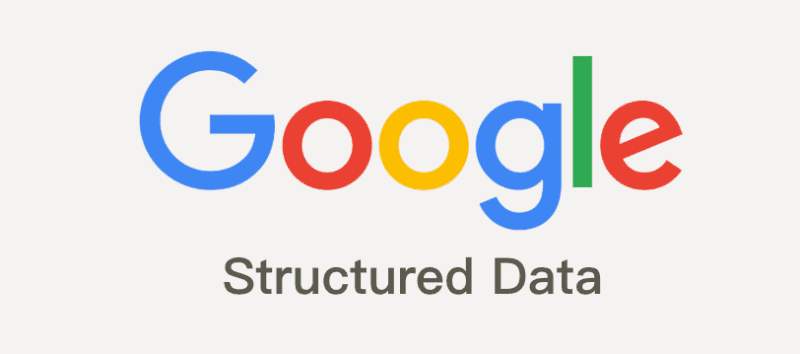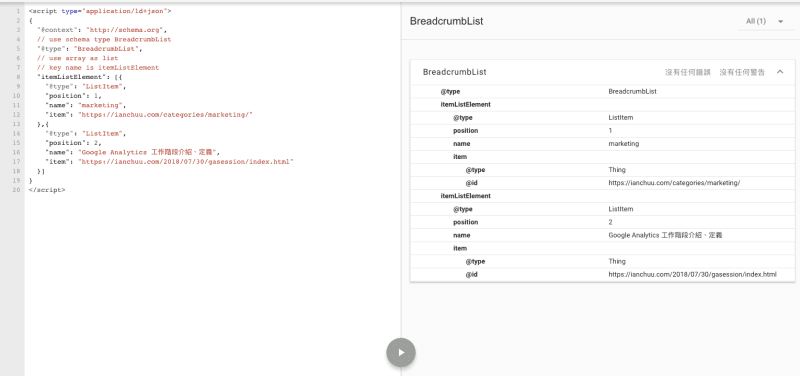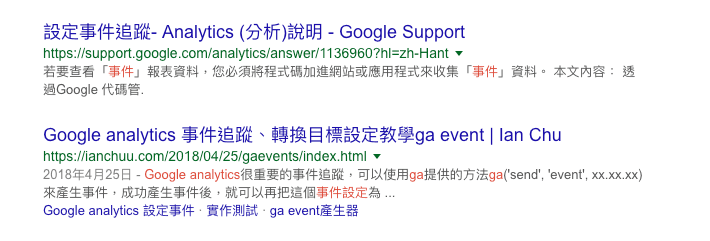過去,搜尋引擎難以理解網站的內容屬性,這時就依靠結構化資料(structured data),這是 Google、Yahoo、Bing 等搜尋引擎根據 schema.org 制定的標記,共同的去支援。這些標記多半是關於網站內容的一些分類,麵包屑(breadcrumb)、文章(article)、活動(event)、影片(video)等等。
當你網站有依照規範使用這些標記,就會有助於搜尋引擎理解網站的內容。最重要、也最有回饋感的是,會直接讓網站在搜尋結果顯示更不一樣,間接地幫助提高網站點擊率。google 官方有非常詳盡的支援標籤,以及使用過後搜尋結果的變化。
接下來會分享些使用標籤的範例、心得。
google 介紹 : google structured data info
google 支援標籤 : google support structured data
結構化標記語法
有三種語法可以使用,分別為 JSON-LD(google 推薦)、Microdata、RDFa,JSON-LD 是 javascript 的語法類型,這只是 javascript 的資料所以不會顯示在畫面上,Microdata 則是在 html 上標記,所以就需要依賴實際存在的 html 來加入,RDFa 類似 Microdata,是基於 html5 的標記,但語法與 Microdata 不大相同,但邏輯非常類似。
我個人是比較喜歡用 JSON-LD 的語法,因為比較簡潔好讀寫,看下面範例比較應該很好理解。google 官方是表示三種方法並沒有差異,選擇方便使用的語法即可,但是提醒一下滿多屬性並不支援 Microdata。
稍微介紹一下 JSON 資料的概念,大概就是 key -> value,key 可以當作名稱,value 則當作值。{ } 稱作為物件,相同一筆的資料都會包覆在這個符號內,[ ] 則是代表陣列,多筆資料的意思。
- JSON-LD Course 範例
<script type="application/ld+json">
{
"@context": "http://schema.org/",
"@type": "schema:Course",
"name": "The Data Scientist's Toolbox",
"description": "In this course you will get an introduction
to the main tools and ideas in the
data scientist's toolbox...",
"hasCourseInstance": {
"@type": "CourseInstance",
"courseMode": ["MOOC","online"],
"endDate": "March 21",
"startDate": "February 15"
}
}
</script>- RDFa Course 範例
<body vocab="http://schema.org/">
<main typeof="Course">
<h1 property="name">The Data Scientist's Toolbox</h1>
<h2>About this Course</h2>
<p property="description">
In this course you will get an introduction to the main tools and ideas in
the data scientist's toolbox...
</p>
<div rel="hasCourseInstance" typeof="CourseInstance">
<meta property="courseMode" content="MOOC" />
<meta property="courseMode" content="online" />
<h2>Session dates</h2>
<span property="startDate">February 15</span> -<span property="endDate">March 21</span>
</div>
</main>
</body>breadcrumb 標記
最實用也最常用的莫過於麵包屑了,通常網站內容都會有不同的分類,例如說今天有某篇 ga 的文章歸類在 marketing,那結構大概會是 marketing › {{文章標題}},俗稱麵包屑。再來來使用 JSON-LD 方法來標記。
首先使用@content 來宣告使用結構化標記,再來以@type 來使用標籤類型 BreadcrumbList,再以陣列[] 來列出多筆,第一筆資料會是 marketing,position 代表排在第一位,name 列上 marketing,item 則列上網址。以此類推往下增加下去,
- JSON-LD breadcrumb
<script type="application/ld+json">
{
"@context": "http://schema.org",
// use schema type BreadcrumbList
"@type": "BreadcrumbList",
// use array as list
// key name is itemListElement
"itemListElement": [{
"@type": "ListItem",
"position": 1,
"name": "marketing",
"item": "https://ianccy.com/categories/marketing/"
},{
"@type": "ListItem",
"position": 2,
"name": "Google Analytics 工作階段介紹、定義",
"item": "https://ianccy.com/gasession/"
}]
}
</script>測試結構化資料
進入網站 google 測試結構化資料,點擊輸入程式碼片段,輸入剛剛那段 JSON,點擊下方驗證後,就可以看到語法有沒有成功,如果有錯誤的話,上面會提供修正的方式。
之後再進入 search console,提交網站索引或是 sitemap,等待搜尋引擎更新索引就大功告成了。
搜尋結果錨點 (非 structured data)
最後再提供一個最近特別用到修改,下方的搜尋結果出現頁面內的錨點,原本 blog 頁面架構就有用 id 錨點),查閱結構化資料過後發現,並沒有錨點可以使用的功能,於是我針對搜尋結果有出現錨點的頁面都看過一次 html。
<h2 id="#錨點名稱">{{ content }}</h2>發現都有相同概念,就是要當你搜尋結果要出現錨點,頁面上就必須要有實體連結可以點過去。於是我就做了頁面左邊的那個點擊 scroll 區塊,大約過了一週後搜尋結果就開始出現錨點。雖然常常一下只顯示麵包屑,一下又只顯示錨點…。
- 目錄範例
<div class="toc-article" id="toc">
<div class="toc-title">文章目錄</div>
<ol class="toc">
<li class="toc-item toc-level-2">
<a class="toc-link" href="#Google-analytics-設定事件">
<span class="toc-text">Google analytics 設定事件</span>
</a>
</li>
<li class="toc-item toc-level-2">
<a class="toc-link" href="#實作測試">
<span class="toc-text">實作測試</span>
</a>
</li>
<li class="toc-item toc-level-2">
<a class="toc-link" href="#ga-event產生器">
<span class="toc-text">ga event產生器</span>
</a>
</li>
...
</ol>
</div>心得
結構化資料出了大概 3、4 年了,突然想到 search console 有螢光筆工具,它可以直接畫記結構資料屬性,我在 3 年前有用過,完成但搜尋結果並沒任何變化。
剩下還有很多的標籤屬性(event、product、recipe、video、article 等等),其實也沒有技術難度,就依照官方文件範例照著填入需要的資料就好了,唯一難處可能是缺資料 XD。
再分享個最近實作結構化資料經驗,完成標記提交網站索引後,大概都要一週後才會漸漸地有變化。



